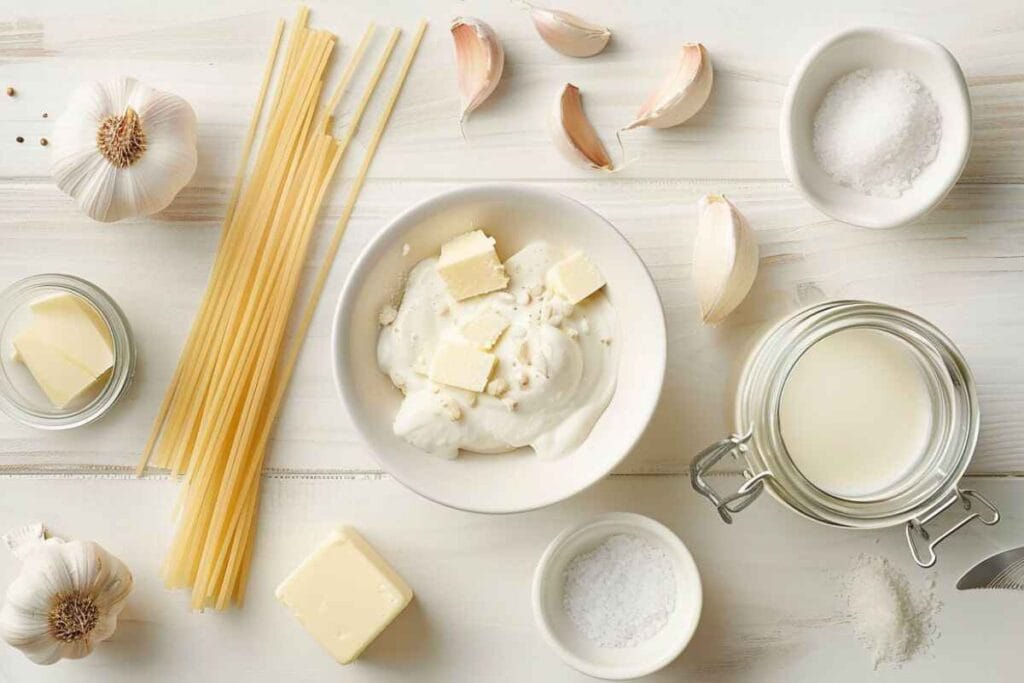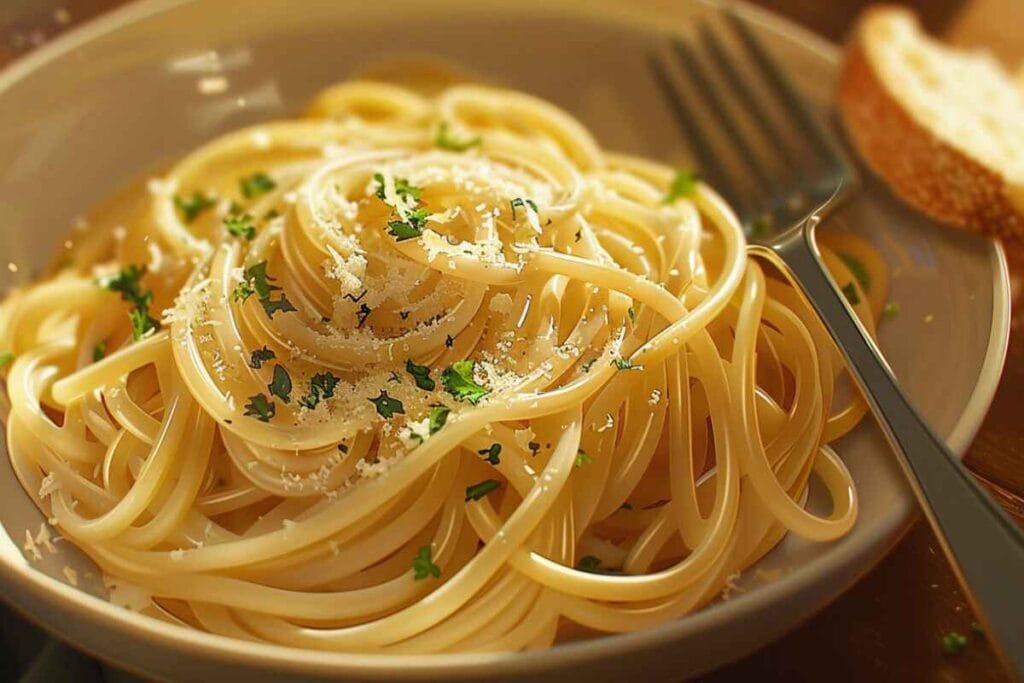Have you ever craved a dish that feels like a warm hug on a cold day? Something creamy, comforting, and oh-so-delicious? Well, cream sauce for spaghetti might be exactly what you’re looking for! This dish is a classic, loved by kids and adults alike, and it’s perfect for just about any occasion—be it a cozy family dinner or a fancy celebration.
Cream sauce, also known as “white sauce” in some households, is rich and velvety, clinging to each strand of spaghetti like it’s meant to be. The best part? You don’t have to be a master chef to make it. Even if you’re a beginner, this guide will walk you through every step, ensuring your sauce turns out creamy and delicious.
As Julia Child once said, “The only real stumbling block is fear of failure. In cooking, you’ve got to have a what-the-hell attitude.” So let’s dive in and create some magic in the kitchen!
Ingredients
Before you start, it’s essential to gather everything you need. Having the ingredients ready not only makes cooking easier but also ensures you don’t miss a step. Here’s what you’ll need to whip up a dreamy cream sauce:

Essential Ingredients:
- Butter (unsalted): 2 tablespoons. This adds richness to the sauce.
- Garlic (minced): 2-3 cloves for a lovely aromatic base.
- Heavy Cream: 1 cup for that creamy texture.
- Milk: ½ cup to balance the creaminess.
- Grated Parmesan Cheese: ½ cup for flavor and a slightly nutty taste.
- All-Purpose Flour: 1 tablespoon to thicken the sauce.
- Salt and Pepper: To taste, because seasoning is key.
- Nutmeg (optional): A pinch for a subtle warmth.
Optional Ingredients:
- Fresh Parsley: Chopped for garnish.
- Red Chili Flakes: If you like a little heat.
- White Wine: A splash to deepen the flavor (optional for adult dishes).
One of the best things about this recipe is its flexibility. Don’t have heavy cream? You can substitute with full-fat milk or even half-and-half. Lactose-intolerant? Swap out the dairy for plant-based alternatives like almond or oat milk, and use vegan butter and cheese.
Tools Needed
Great cooking isn’t just about ingredients—it’s also about the tools you use. Don’t worry, though. You won’t need anything fancy. Most of these items are probably already in your kitchen.
Essential Tools:
- A Large Saucepan: For cooking the sauce evenly.
- A Wooden Spoon or Silicone Spatula: Perfect for stirring without scratching your pan.
- A Whisk: To ensure a smooth, lump-free sauce.
- Measuring Cups and Spoons: For accuracy, especially if this is your first time making cream sauce.
- A Cutting Board and Knife: For chopping garlic and parsley.
Helpful Extras:
- A Cheese Grater: For freshly grating Parmesan (trust me, it’s worth it!).
- Tongs: To mix the spaghetti into the sauce easily.
- A Small Strainer: To sift the flour if needed, preventing clumps.
As they say, “The right tools make all the difference.” Having these items handy will make your cooking experience smoother and more enjoyable.
Step-by-Step Guide
Making cream sauce for spaghetti is easier than you think! By breaking it into simple steps, you’ll have a delicious meal ready in no time. Let’s get started.
Preparing
Preparation is key to smooth cooking. Here’s what you’ll do before turning on the stove:
- Measure Your Ingredients: Have all the ingredients ready. This saves time and prevents mistakes.
- Grate the Parmesan: Freshly grated cheese melts better and adds a more intense flavor.
- Chop Garlic and Parsley: Mince the garlic finely and set aside a small bowl of chopped parsley for garnish.
- Cook the Spaghetti: While you’re preparing the sauce, cook your spaghetti in salted boiling water until al dente. Drain it and toss with a little olive oil to keep it from sticking.
Pro Tip: Save about ½ cup of the pasta water. This starchy liquid can be added later to adjust the sauce’s thickness and help it stick to the spaghetti.
Cooking
Now it’s time to bring your cream sauce to life! Follow these steps for a silky, flavorful sauce:
- Melt the Butter: Heat your saucepan over medium heat. Add the butter and let it melt completely.
- Sauté the Garlic: Add the minced garlic to the butter and sauté for about 30 seconds until fragrant. Be careful not to let it brown—it can turn bitter.
- Make a Roux: Sprinkle the flour over the melted butter and garlic. Stir constantly with a whisk to create a smooth paste. Cook this mixture for 1-2 minutes to remove the raw flour taste.
- Add the Liquids: Gradually pour in the milk and cream while whisking. This prevents lumps from forming. Keep stirring until the mixture starts to thicken.
- Incorporate Cheese and Seasonings: Stir in the grated Parmesan cheese, salt, pepper, and a pinch of nutmeg (if using). Continue whisking until the cheese melts and the sauce is smooth.
- Adjust the Thickness: If the sauce feels too thick, add a splash of reserved pasta water or extra milk until you reach your desired consistency.
Quote to Remember: “Cooking is like love; it should be entered into with abandon or not at all.” – Harriet Van Horne. So don’t hold back—taste your sauce as you go and adjust the seasoning!
Assembling
This is the fun part—bringing it all together!
- Combine the Spaghetti and Sauce: Add the cooked spaghetti to the saucepan with the cream sauce. Use tongs or a fork to toss the pasta until every strand is coated in the creamy goodness.
- Let It Simmer: Allow the spaghetti and sauce to cook together for 1-2 minutes. This helps the flavors meld and ensures the sauce clings to the pasta.
- Garnish: Plate the spaghetti and sprinkle with chopped parsley, additional Parmesan, or red chili flakes for an extra pop of flavor.
Pro Tip: Serve the dish immediately for the best taste and texture. Cream sauces can thicken as they cool, so enjoy it fresh!
Serving Suggestions
Cream sauce for spaghetti is versatile and pairs beautifully with many dishes. Here are a few ways to serve it:
- Classic Comfort Food: Serve it as-is, topped with a sprinkle of Parmesan and fresh parsley. It’s simple yet indulgent.
- With Protein: Add grilled chicken, sautéed shrimp, or pan-seared scallops for a heartier meal. The sauce’s creaminess complements these proteins perfectly.
- Vegetarian Delight: Toss in sautéed mushrooms, spinach, or roasted cherry tomatoes for a vegetarian twist. These add texture and a pop of color.
- Family Feast: Pair it with a side of garlic bread and a crisp Caesar salad for a complete dinner.
Variations
Dietary Adjustments for Cream Sauce for Spaghetti
- Dairy-Free Version: Use plant-based milk (like almond or cashew) and vegan butter. Nutritional yeast can replace Parmesan for a cheesy flavor.
- Gluten-Free Option: Swap the all-purpose flour with a gluten-free alternative, like rice flour or cornstarch.
- Lower-Calorie Version: Use half-and-half instead of heavy cream and reduce the butter. You’ll still get a creamy sauce without the extra calories.
Flavor Enhancements
- Herb-Infused Sauce: Add fresh basil, thyme, or oregano for a fragrant twist.
- Zesty Lemon Touch: Squeeze in some fresh lemon juice or add zest for brightness.
- Spicy Kick: Stir in a pinch of cayenne pepper or a drizzle of hot sauce for a hint of heat.
Common Mistakes and How to Avoid Them
- Lumpy Sauce: Always whisk continuously when adding flour and liquids to prevent lumps. Adding milk too quickly can cause this issue.
- Overcooked Garlic: Garlic burns quickly, so sauté it over medium heat for no more than 30 seconds.
- Too Thick or Too Thin: Use pasta water or milk to adjust consistency. If it’s too runny, let the sauce simmer a bit longer to thicken.
- Clumpy Cheese: Use freshly grated Parmesan and add it off the heat. Pre-shredded cheese can sometimes clump due to added stabilizers.
Nutritional Benefits
Health Benefits of Cream Sauce for Spaghetti
Cream sauce, when made with fresh ingredients, offers nutritional value like calcium from the milk and cheese and antioxidants from garlic. If you include vegetables or lean proteins, it becomes even more wholesome.
Calories and Macronutrients of Cream Sauce for Spaghetti
A typical serving of cream sauce for spaghetti contains approximately:
- Calories: 400-450 (varies based on adjustments)
- Protein: 12-15g (more with added proteins like chicken or shrimp)
- Fat: 20-25g
- Carbohydrates: 35-40g
For a lighter option, reduce the butter and use milk instead of cream.
Pairing Suggestions for Cream Sauce for Spaghetti
Wondering what to serve alongside this dish? Here are some tasty ideas:
- Sides: Garlic bread, bruschetta, or a simple arugula salad with lemon vinaigrette.
- Beverages: Pair it with sparkling water, lemonade, or a refreshing iced tea for a family-friendly option.
- Desserts: End the meal with a light dessert like fresh fruit salad or vanilla panna cotta.
As someone once said, “A great meal is a journey that should end on a sweet note.” And this creamy spaghetti is definitely a journey worth taking.
Frequently Asked Questions
What is spaghetti sauce with cream called?
Spaghetti sauce with cream is often referred to as cream sauce or white sauce. In Italian cuisine, it may also be called pasta alla panna, which translates to “pasta with cream.” When paired with other ingredients like cheese, it can resemble Alfredo sauce, but without the heavy reliance on butter and Parmesan.
Is cream sauce the same as Alfredo sauce?
Not exactly! Cream sauce is a broader term and can be made with a variety of ingredients like milk, cream, butter, and flour for thickening. Alfredo sauce, on the other hand, is a specific type of cream sauce that typically uses butter, heavy cream, and Parmesan cheese, without a thickening agent like flour. Alfredo sauce is richer and cheesier compared to a basic cream sauce.
What is a spaghetti sauce called?
Spaghetti sauce can vary widely in type and flavor. It’s usually named based on its main ingredients:
- Marinara Sauce: Tomato-based with garlic and herbs.
- Bolognese Sauce: A meat-based tomato sauce.
- Pesto Sauce: Made from basil, pine nuts, and olive oil.
- Cream Sauce: Rich and creamy, made with dairy. The name reflects the style and origin of the sauce being served with the spaghetti.
Why add cream to spaghetti sauce?
Adding cream to spaghetti sauce gives it a rich, velvety texture and a slightly sweet flavor. It balances the acidity of tomato-based sauces, making them smoother and more luxurious. In cream-based sauces, it serves as the main ingredient, creating that indulgent, creamy finish that coats the pasta perfectly. Cream transforms a simple dish into a comforting and satisfying meal.
Conclusion for Cream Sauce for Spaghetti

Final Thoughts
Cream sauce for spaghetti is more than just a recipe—it’s an experience. It’s one of those dishes that brings everyone to the table, sparks conversation, and leaves you feeling satisfied. Whether you’re making it for your family or just for yourself, it’s bound to be a hit.
And remember, cooking isn’t about perfection. It’s about creating something with love and enjoying the process. As my grandmother always said, “The secret ingredient in every dish is a little bit of your heart.”
Call to Action
Now that you know all the secrets to making the best cream sauce for spaghetti, it’s time to try it out! Gather your ingredients, roll up your sleeves, and create a meal that will wow your family and friends. Who’s ready to dig in?

